The Your Windows OS is damaged is just one of the many web pages of the so-called misleading advertising type. It’s developed to force you into installing a malicious software. If the internet browser from time to time redirects to the “Your Windows OS is damaged” page then most probably that your personal computer is affected by an obnoxious unwanted software from the ‘ad-supported’ software (also known as adware) family. The adware is created in order to provide third-party ads to the user without asking his permission. The ad-supported software takes control of all your typical web browsers and redirects them to ad, malicious and misleading sites such as the “Your Windows OS is damaged” every time you surf the Internet.
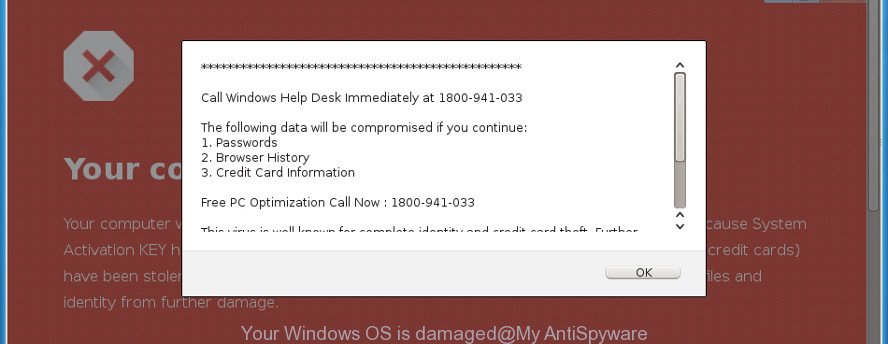
The “Your Windows OS is damaged” alert is a misleading advertising like shown on the image above
What is more, the ad-supported software that causes multiple misleading “Your Windows OS is damaged” alerts and pop-ups, may open ads depend on a web page that you are visiting. That is, it’s clear that this ad-supported software, without your permission, steals confidential data about you such as: your ip address, what is a webpage you are viewing now, what you are looking for on the Internet, which links you are clicking, and much, much more. Even worse, the adware may monetize its functionality by collecting confidential data from your browsing sessions. This privacy information, later, can be easily sold to third parties. This puts your user information at a security risk.
The adware usually infects only the FF, Google Chrome, Microsoft Internet Explorer and Edge by modifying the browser’s settings or installing a harmful addons. Moreover, possible situations, when any other web-browsers will be affected too. The adware will perform a scan of the machine for web browser shortcut files and modify them without your permission. When it infects the web-browser shortcuts, it’ll add the argument such as ‘http://site.address’ into Target property. So, each time you run the web browser, you will see an undesired “Your Windows OS is damaged” web site.
We advise to delete the adware that causes multiple misleading “Your Windows OS is damaged” alerts and pop-ups, as soon as you found this problem, as it can redirect your internet browser to web-resources that may load other harmful software on your personal computer.
How to remove “Your Windows OS is damaged” pop up scam
There are a simple manual instructions below which will assist you to remove “Your Windows OS is damaged” pop up warnings from your Windows personal computer. The most effective solution to delete this adware is to complete the manual removal tutorial and then use Zemana Anti Malware, MalwareBytes or Hitman Pro automatic tools (all are free). The manual solution will assist to weaken this ad supported software and these malware removal utilities will completely remove “Your Windows OS is damaged” pop-up and revert back the Internet Explorer, Mozilla Firefox, Chrome and Edge settings to default.
To remove “Your Windows OS is damaged”, perform the steps below:
- Manual “Your Windows OS is damaged” pop up removal
- Uninstall questionable programs using Windows Control Panel
- Get rid of unwanted Scheduled Tasks
- Fix affected browsers shortcuts to remove “Your Windows OS is damaged” redirect
- Remove “Your Windows OS is damaged” popup scam from IE
- Get rid of “Your Windows OS is damaged” from FF by resetting web-browser settings
- Remove “Your Windows OS is damaged” popup warnings from Google Chrome
- “Your Windows OS is damaged” fake alerts automatic removal
- How to block “Your Windows OS is damaged” pop-up warnings
- How did “Your Windows OS is damaged” fake alerts get on your personal computer
- Finish words
Manual “Your Windows OS is damaged” pop up removal
If you perform exactly the step-by-step guide below you should be able to remove the “Your Windows OS is damaged” fake alerts from the Microsoft Internet Explorer, Mozilla Firefox, Edge and Google Chrome internet browsers.
Uninstall questionable programs using Windows Control Panel
First, go to MS Windows Control Panel and remove dubious software, all programs you do not remember installing. It’s important to pay the most attention to software you installed just before “Your Windows OS is damaged” fake alerts appeared on your browser. If you do not know what a program does, look for the answer on the Internet.
Windows 8, 8.1, 10
First, click Windows button

After the ‘Control Panel’ opens, click the ‘Uninstall a program’ link under Programs category as shown below.

You will see the ‘Uninstall a program’ panel as shown on the image below.

Very carefully look around the entire list of software installed on your PC. Most probably, one of them is the adware which causes misleading “Your Windows OS is damaged” fake alerts on your browser. If you have many applications installed, you can help simplify the search of harmful programs by sort the list by date of installation. Once you have found a suspicious, unwanted or unused program, right click to it, after that click ‘Uninstall’.
Windows XP, Vista, 7
First, press ‘Start’ button and select ‘Control Panel’ at right panel as displayed below.

When the Windows ‘Control Panel’ opens, you need to press ‘Uninstall a program’ under ‘Programs’ as displayed on the image below.

You will see a list of apps installed on your computer. We recommend to sort the list by date of installation to quickly find the software that were installed last. Most probably, it is the ‘ad supported’ software which created to show misleading “Your Windows OS is damaged” popup scam within your web-browser. If you are in doubt, you can always check the program by doing a search for her name in Google, Yahoo or Bing. After the application which you need to delete is found, simply click on its name, and then click ‘Uninstall’ as on the image below.

Get rid of unwanted Scheduled Tasks
If the intrusive “Your Windows OS is damaged” web-page opens automatically on Windows startup or at equal time intervals, then you need to check the Task Scheduler Library and remove all tasks that have been created by adware.
Press Windows and R keys on the keyboard together. This displays a dialog box that titled as Run. In the text field, type “taskschd.msc” (without the quotes) and click OK. Task Scheduler window opens. In the left-hand side, click “Task Scheduler Library”, as displayed below.
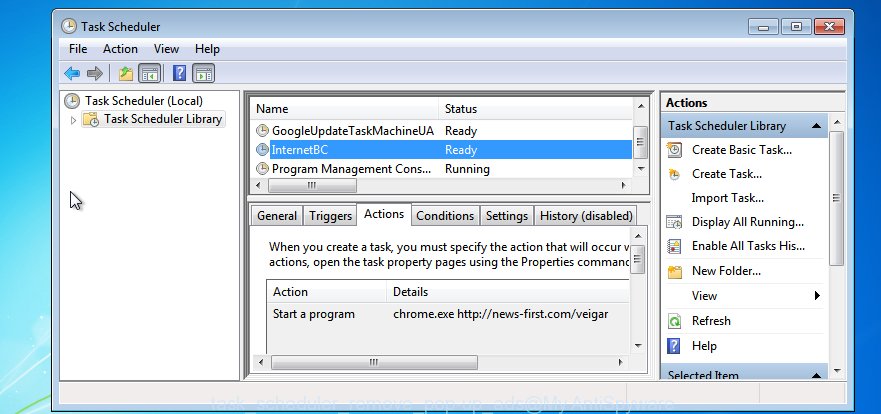
Task scheduler
In the middle part you will see a list of installed tasks. Please select the first task, its properties will be display just below automatically. Next, press the Actions tab. Pay attention to that it launches on your PC system. Found something like “explorer.exe http://site.address” or “chrome.exe http://site.address”, then delete this malicious task. If you are not sure that executes the task, check it through a search engine. If it’s a component of the malicious software, then this task also should be removed.
Having defined the task that you want to remove, then click on it with the right mouse button and select Delete as displayed on the screen below.

Delete a task
Repeat this step, if you have found a few tasks which have been created by unwanted apps. Once is done, close the Task Scheduler window.
Fix affected browsers shortcuts to remove “Your Windows OS is damaged” redirect
Now you need to clean up the internet browser shortcut files. Check that the shortcut file referring to the right exe-file of the web-browser, and not on any unknown file.
Right click on the shortcut file of hijacked web-browser as shown below.
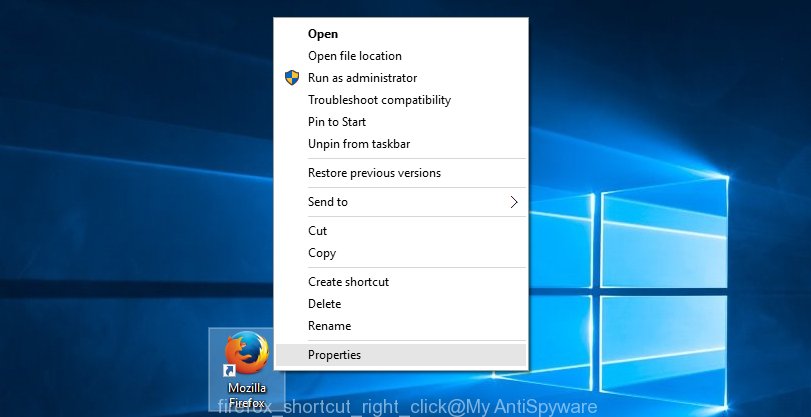
Select the “Properties” option and it will show the shortcut file’s properties. Next, press the “Shortcut” tab and then delete the “http://site.address” string from Target field as displayed on the screen below.
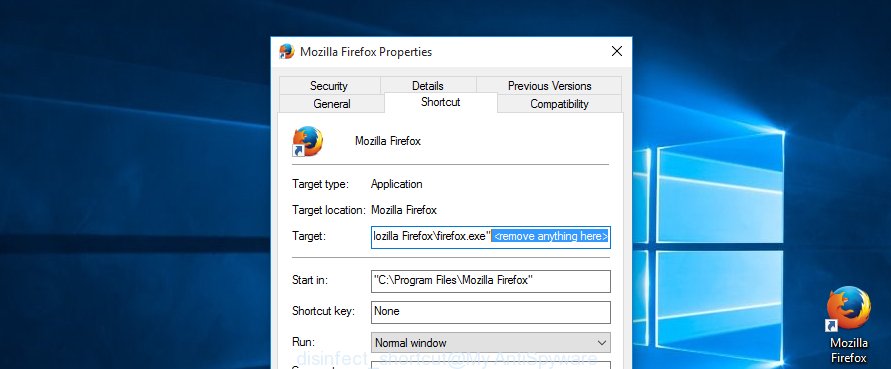
Then click OK to save changes. Repeat the step for all web-browsers that are re-directed to the “Your Windows OS is damaged” intrusive web site.
Remove “Your Windows OS is damaged” popup scam from IE
By resetting Microsoft Internet Explorer web-browser you revert back your internet browser settings to its default state. This is first when troubleshooting problems that might have been caused by adware which designed to display misleading “Your Windows OS is damaged” fake alerts within your internet browser.
First, start the Internet Explorer. Next, click the button in the form of gear (![]() ). It will open the Tools drop-down menu, click the “Internet Options” as shown below.
). It will open the Tools drop-down menu, click the “Internet Options” as shown below.

In the “Internet Options” window click on the Advanced tab, then click the Reset button. The Internet Explorer will show the “Reset Internet Explorer settings” window like below. Select the “Delete personal settings” check box, then click “Reset” button.

You will now need to reboot your PC system for the changes to take effect.
Get rid of “Your Windows OS is damaged” from FF by resetting web-browser settings
The Mozilla Firefox reset will keep your personal information such as bookmarks, passwords, web form auto-fill data, restore preferences and security settings, get rid of redirects to unwanted “Your Windows OS is damaged” web site and adware.
First, open the Firefox. Next, click the button in the form of three horizontal stripes (![]() ). It will show the drop-down menu. Next, click the Help button (
). It will show the drop-down menu. Next, click the Help button (![]() ).
).

In the Help menu click the “Troubleshooting Information”. In the upper-right corner of the “Troubleshooting Information” page click on “Refresh Firefox” button like below.

Confirm your action, press the “Refresh Firefox”.
Remove “Your Windows OS is damaged” popup warnings from Google Chrome
Reset Google Chrome settings is a easy way to delete the browser hijackers, malicious and ‘ad-supported’ extensions, as well as to recover the internet browser’s newtab, startpage and search provider that have been modified by adware which shows misleading “Your Windows OS is damaged” popup warnings on your computer.
First launch the Google Chrome. Next, click the button in the form of three horizontal dots (![]() ).
).
It will display the Chrome menu. Select More Tools, then click Extensions. Carefully browse through the list of installed extensions. If the list has the extension signed with “Installed by enterprise policy” or “Installed by your administrator”, then complete the following steps: Remove Google Chrome extensions installed by enterprise policy.
Open the Chrome menu once again. Further, click the option named “Settings”.

The internet browser will display the settings screen. Another solution to open the Chrome’s settings – type chrome://settings in the internet browser adress bar and press Enter
Scroll down to the bottom of the page and click the “Advanced” link. Now scroll down until the “Reset” section is visible, as on the image below and click the “Reset settings to their original defaults” button.

The Chrome will open the confirmation prompt as on the image below.

You need to confirm your action, press the “Reset” button. The browser will launch the procedure of cleaning. After it is complete, the browser’s settings including new tab page, default search provider and home page back to the values that have been when the Google Chrome was first installed on your computer.
“Your Windows OS is damaged” fake alerts automatic removal
The ad-supported software can hide its components which are difficult for you to find out and remove completely. This can lead to the fact that after some time, the adware which causes misleading “Your Windows OS is damaged” pop up warnings on your web-browser once again infect your PC system. Moreover, We want to note that it’s not always safe to remove adware manually, if you do not have much experience in setting up and configuring the MS Windows operating system. The best solution to detect and delete ‘ad supported’ software is to run free malicious software removal programs.
How to get rid of “Your Windows OS is damaged” pop up with Zemana Anti-malware
You can remove “Your Windows OS is damaged” popup scam automatically with a help of Zemana Anti-malware. We recommend this malware removal tool because it may easily remove browser hijacker infections, potentially unwanted applications, adware which redirects your browser to “Your Windows OS is damaged” webpage with all their components such as folders, files and registry entries.
Zemana AntiMalware can be downloaded from the following link. Save it on your MS Windows desktop or in any other place.
164748 downloads
Author: Zemana Ltd
Category: Security tools
Update: July 16, 2019
Once downloading is complete, close all windows on your computer. Further, run the setup file named Zemana.AntiMalware.Setup. If the “User Account Control” dialog box pops up as shown below, click the “Yes” button.

It will show the “Setup wizard” which will assist you install Zemana Free on the computer. Follow the prompts and do not make any changes to default settings.

Once setup is complete successfully, Zemana Anti-Malware (ZAM) will automatically start and you can see its main window as shown in the figure below.

Next, press the “Scan” button for scanning your machine for the ad-supported software which cause misleading “Your Windows OS is damaged” pop up scam to appear. A scan can take anywhere from 10 to 30 minutes, depending on the number of files on your computer and the speed of your PC. While the Zemana Anti Malware (ZAM) application is checking, you can see number of objects it has identified as threat.

When Zemana AntiMalware completes the scan, Zemana Free will display a list of found items. Make sure all threats have ‘checkmark’ and click “Next” button.

The Zemana will delete ‘ad supported’ software which made to display misleading “Your Windows OS is damaged” fake alerts within your internet browser and move threats to the program’s quarantine. When finished, you can be prompted to restart your personal computer.
Remove “Your Windows OS is damaged” popup from browsers with HitmanPro
The HitmanPro tool is free (30 day trial) and easy to use. It can scan and delete malicious software, potentially unwanted applications and ad-supported software in Firefox, IE, Edge and Chrome web-browsers and thereby remove all unwanted “Your Windows OS is damaged” popup ads. HitmanPro is powerful enough to find and remove malicious registry entries and files that are hidden on the personal computer.
Installing the Hitman Pro is simple. First you’ll need to download HitmanPro by clicking on the following link.
When the downloading process is finished, open the file location. You will see an icon like below.

Double click the Hitman Pro desktop icon. When the tool is opened, you will see a screen like below.

Further, click “Next” button to perform a system scan with this utility for the adware which cause misleading “Your Windows OS is damaged” pop-up warnings to appear. A system scan may take anywhere from 5 to 30 minutes, depending on your PC system. When the scan get finished, a list of all threats found is produced as shown in the following example.
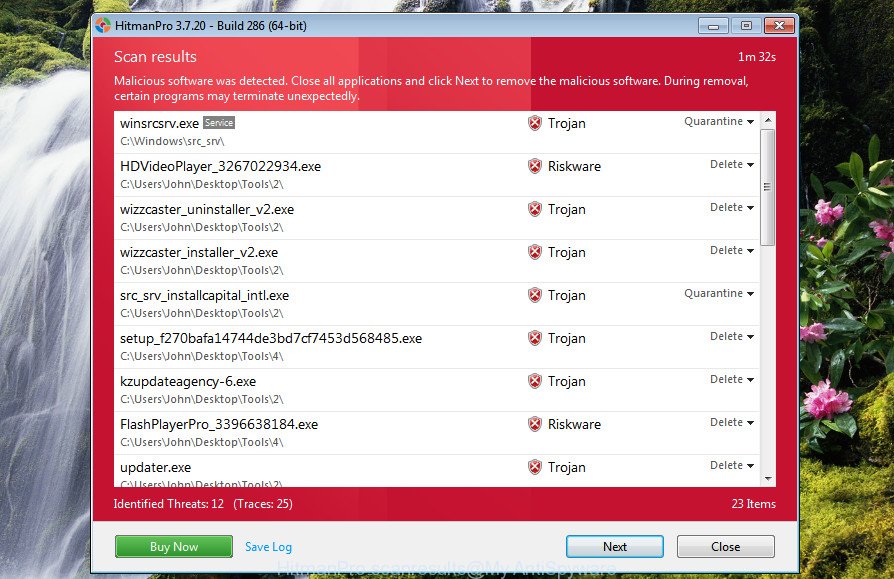
Next, you need to click “Next” button. It will open a dialog box, click the “Activate free license” button.
Use Malwarebytes to remove “Your Windows OS is damaged” fake alerts
You can remove “Your Windows OS is damaged” pop up warnings automatically with a help of Malwarebytes Free. We advise this free malware removal tool because it can easily delete hijackers, adware, potentially unwanted software and toolbars with all their components such as files, folders and registry entries.
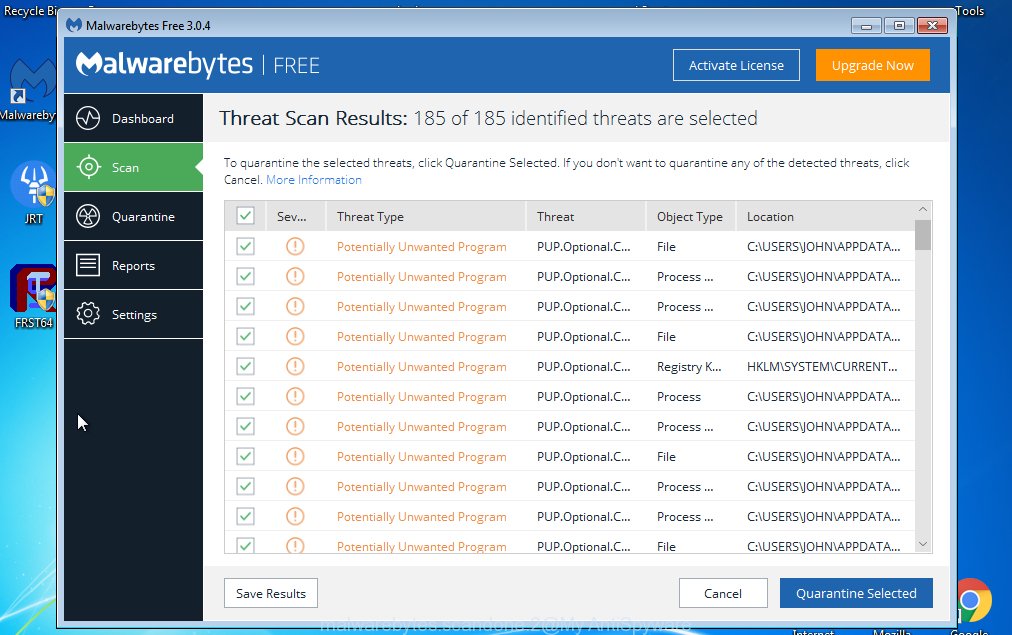
- Download MalwareBytes Anti Malware by clicking on the link below. Save it on your MS Windows desktop.
Malwarebytes Anti-malware
327014 downloads
Author: Malwarebytes
Category: Security tools
Update: April 15, 2020
- At the download page, click on the Download button. Your web-browser will show the “Save as” prompt. Please save it onto your Windows desktop.
- Once the downloading process is done, please close all apps and open windows on your PC. Double-click on the icon that’s named mb3-setup.
- This will run the “Setup wizard” of MalwareBytes AntiMalware onto your personal computer. Follow the prompts and do not make any changes to default settings.
- When the Setup wizard has finished installing, the MalwareBytes AntiMalware (MBAM) will start and open the main window.
- Further, click the “Scan Now” button to perform a system scan for the adware that causes internet browsers to display misleading “Your Windows OS is damaged” popup scam. A system scan may take anywhere from 5 to 30 minutes, depending on your personal computer. While the MalwareBytes Anti Malware is scanning, you may see how many objects it has identified either as being malicious software.
- When finished, MalwareBytes Anti Malware will display a list of found threats.
- All found threats will be marked. You can delete them all by simply click the “Quarantine Selected” button. When disinfection is finished, you may be prompted to reboot the PC system.
- Close the Anti Malware and continue with the next step.
Video instruction, which reveals in detail the steps above.
How to block “Your Windows OS is damaged” pop-up warnings
It is important to use adblocker apps such as AdGuard to protect your PC system from malicious web pages. Most security experts says that it’s okay to stop advertisements. You should do so just to stay safe! And, of course, the AdGuard can to stop “Your Windows OS is damaged” and other unwanted web sites.
AdGuard can be downloaded from the following link. Save it on your MS Windows desktop or in any other place.
26828 downloads
Version: 6.4
Author: © Adguard
Category: Security tools
Update: November 15, 2018
When the downloading process is finished, double-click the downloaded file to launch it. The “Setup Wizard” window will show up on the computer screen as shown in the following example.

Follow the prompts. AdGuard will then be installed and an icon will be placed on your desktop. A window will show up asking you to confirm that you want to see a quick guide as displayed below.

Click “Skip” button to close the window and use the default settings, or click “Get Started” to see an quick guidance which will help you get to know AdGuard better.
Each time, when you run your PC, AdGuard will launch automatically and block pop-up ads, “Your Windows OS is damaged” redirect, as well as other harmful or misleading web pages. For an overview of all the features of the program, or to change its settings you can simply double-click on the AdGuard icon, that may be found on your desktop.
How did “Your Windows OS is damaged” fake alerts get on your personal computer
These days some free software authors bundle optional apps which could be potentially unwanted software such as this ad-supported software, with a view to making some money. These are not free programs as install an unwanted software on to your MS Windows PC. So whenever you install a new free program that downloaded from the World Wide Web, be very careful during install. Carefully read the EULA (a text with I ACCEPT/I DECLINE button), choose custom or manual installation type, reject all bundled programs.
Finish words
Now your computer should be clean of the ‘ad supported’ software which shows misleading “Your Windows OS is damaged” pop-up scam on your PC system. We suggest that you keep AdGuard (to help you block unwanted popups and unwanted harmful sites) and Zemana (to periodically scan your personal computer for new adwares and other malicious software). Probably you are running an older version of Java or Adobe Flash Player. This can be a security risk, so download and install the latest version right now.
If you are still having problems while trying to delete “Your Windows OS is damaged” pop-up scam from the Internet Explorer, FF, Microsoft Edge and Google Chrome, then ask for help in our Spyware/Malware removal forum.




















